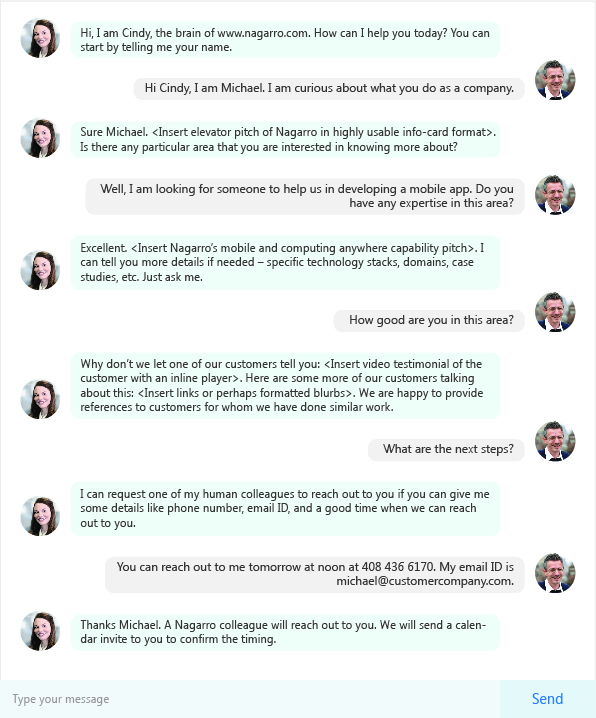
Vaibhav Gadodia
 Lately, there has been a lot of buzz about Chatbots – applications that make use of a conversational user interface instead of a graphical interface that has been the norm in the past decade or three. With any buzz-worthy technology, there is the usual confusion about what exactly is a Chatbot – and depending on how many articles you have read, it is anywhere between a simplified IVR or the technology which will result in world peace.
Lately, there has been a lot of buzz about Chatbots – applications that make use of a conversational user interface instead of a graphical interface that has been the norm in the past decade or three. With any buzz-worthy technology, there is the usual confusion about what exactly is a Chatbot – and depending on how many articles you have read, it is anywhere between a simplified IVR or the technology which will result in world peace.
- The rise of messaging for social interaction, commerce, and collaboration - it’s a user interface that most of the world is already trained on.
- Tooling and technology advances in natural language processing and related technologies – frameworks from companies like Microsoft, Facebook, and many others provide the plumbing and infrastructure to create a Chatbot which can be talked to using natural languages.
- Advances in AI and machine learning – capabilities in providing deep conversational experiences behind a Chatbot (instead of shallow conversation trees of yesteryear) provides the possibility of really compelling use-cases.
All businesses must think whether they need to have a strategy to have a “Conversational App” – just like they all had to for mobile apps. Bot-directories on the Internet are already full of shallow and meaningless Chatbots, just like app stores were when mobile apps became all the rage.
What kind of Chatbot is right for businesses?
I put this question to myself: what kind of Chatbot is right for Nagarro? I decided to operate with two broad guidelines when answering this question:
- What it should not be: something that can be conversational but adds no extra value or competitive advantage by being so – that is, the alternative GUI/app based approach works almost or just as well or better. Without this constraint, it is easy to think of “me-too” type use cases which look great but may not add business value.
- What it should be: something that changes the quality of interaction for the end-user greatly by being conversational – either because of increased usability, or because the use case just doesn’t feel natural without a conversational interface.
For some businesses, a Chatbot may be necessary channel just to keep up with competition - retailers, eCommerce companies, product helpdesks, etc. may fall into this category. For Nagarro, it is not. In the rest of this article, I describe two Chatbots that Nagarro can benefit from greatly. I believe that both cases described below can be implemented with technology platforms available publicly or commercially today.
Chatbot 1:www.nagarro.comA visitor to our website presents us an opportunity to create a conversation. Traditionally, we hope that we can entice visitors with the content quality, design, and information architecture of our website so that they will hit the “contact us” button and allow us to begin a conversation with them. An intelligent conversational UI, front-and-center of the website, flips this paradigm. The first interaction with the customer is a conversation. Imagine this:

This scenario is very doable today. Chatbots can process natural language queries, measure sentiment, remember the conversation and use historical context to construct future responses. The website can feed the conversation logic through aggressively tagging and structuring the content, or add some machine learning for content discoverability and identification. This interaction becomes richer if the visitor had used an authenticated channel such as Facebook, WhatsApp, Skype, or others to interact – then we already start with information about the visitor.
Chatbot 2: Super recruiter bot
Being a growing company, Nagarro has a continuous hiring process. For a given candidate, a recruiter has to do all of these and more:
- analyze the resume of the candidate,
- ask questions for validating points on the resume,
- answer questions that the candidate may have about the company, the opportunity, the pay scales, the culture, work-life balance, etc.
- describe job openings
This is before we even start interviewing the candidate on skills and suitability. Typically, this is done through a phone call and form-based input on Taleo, our hiring solution. This is time-consuming, requires adding more people as we scale, requires training them and re-training them to communicate this information correctly.
Now imagine a scenario where candidates can simply interact with a Chatbot. The advantages:
- scalability – we can handle many more candidates per unit time.
- consistency – we can control the quality of conversation with the candidates and make it consistent.
- usability – the candidate can do this over channels which are easier to interact with than the phone. They can pause and resume conversations.
- measurement – we can see what type of conversations result in better interest from candidates – difficult to measure in fluid person-to-person communication.
- knowledge – we can build-in more knowledge than a human can process. The super recruiter has knowledge of all job openings and their requirements. It develops knowledge on what skills are related - so if someone mentions frontend development on their resume and we are looking for people skilled in angular.js, then the bot can ask that question to the candidate and it will be a meaningful question.
- richness of content - because of the medium involved (not over phone), the bot can share richer information with the candidate: a question about culture – play an inline video present on YouTube about the culture; a question about employee satisfaction – insert relevant reviews from Glassdoor.
A bot like this can save recruiters time and they can focus on higher-level activities such as improving candidate experience when they are in the office. It can create better engagements with the candidates which starts us off on the right foot in our engagement with them.
So, does my business need a Chatbot?
While brainstorming on this question, I came up with a lot of Chatbot ideas. Some of them were good like the ones above. Many were not. For instance, a Chatbot for mentoring or a Chatbot for searching enterprise data. The first one removes the real need for human interaction in a mentoring context (at least for now, that is still a need). The second one doesn’t add any major benefit over existing enterprise search tools like Microsoft Delve – just a fun channel.
The right questions to ask on whether our business needs a Chatbot are no different from any other tool, app, or investment that we make to improve our business: does making a Chatbot for a particular function offer me a competitive advantage in any way?




